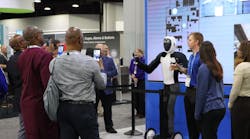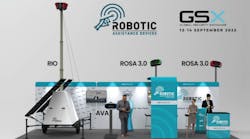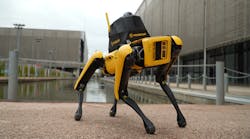Tech Trends: Four reasons why robotics and drones took center stage at GSX
This article originally appeared in the December 2022 issue of Security Business magazine. When sharing, don’t forget to mention Security Business magazine on LinkedIn and @SecBusinessMag on Twitter.
The recent Global Security Exchange (GSX) show in Atlanta was filled with much of the same technology and services the security industry has come to expect; however, there were a few gems sprinkled throughout the expo floor – many of which were connected to the robotics industry.
One thing that seemed to catch the eye of almost everyone walking through was Spot, Boston Dynamic’s quadruped unmanned ground vehicle (Q-UGV) and his many different colors. Spot could be seen patrolling the booths and was even caught dancing at the Friends of Chuck Texas Night event.
Spot was just one of the many robot and drone technologies unveiled. ADT Commercial doubled down on robots and drones with a humanoid robot on wheels on display, as well as an indoor drone system resulting from its partnership with Israel-based Indoor Robotics.
SMP Robotics had a four-wheel drive robot for display, as did Robotic Assistance Devices (RAD), which revealed RIO (ROSA Independent Observatory), a solar powered mast with RAD’s ROSA detection platform.
Outside of the expo, Johnson Controls re-unveiled its Ava Robotics partnership robot in their innovation suite. Knightscope, the maker of the indoor and outdoor robots, held a Robot Roadshow at Underground Atlanta just a mile from the GSX venue.
While the drones and robots were the novelty centerpiece that grabbed the attention of the masses, they brought with them companies to prevent the use of these technologies against sites. Radar companies like Magos and Navtech, as well drone detection technologies Dedrone and 911 Security received interest as well.
All told, there were more than 30 companies demonstrating some version of autonomous patrol, or the ability to detect unmanned vehicles.
Why Now?
Many of our childhood heroes included C3P0, R2-D2, Optimus Prime, Robby the Robot, and Johnny 5 from Short Circuit. Later, many of us got a taste of what could go wrong when artificial intelligence goes awry – when Skynet launches the Terminator, or when the robots revolted against the humans in I, Robot.
Are we closing in on that reality?
There would not have been 30-plus companies exhibiting the robotics and drone related technology if there was not a market. So, what has changed? What has made robots part of the future?
People have been fascinated with robots since their inception. Here are four primary factors that point to why robots and drones have taken a foothold in security:
1. The pandemic: For all the horrible things that it did to society, COVID-19 also showed companies that they needed to be able to effectively monitor sites – both indoor and outdoor – even when the workforce was brought to its knees. Robots could be eyes and ears, with limited ability to solve basic problems like calling 911 or providing directions. Robots could be sanitized frequently and could operate for long stretches with minimal expectations.
2. Augmenting the guard: Security guard companies are continuously faced with the difficult task of finding capable and qualified guards. Once they are found, the companies deal with an extremely high turnover rate once they are hired; in fact, the Service Employees International Union (SEIU) reports a 100-300% annual turnover rate.
Guard companies may have reached a point where a human guard is no longer totally reliable. Most drone and robot technologies lead sales pitches as augments to guards, not replacements. Some guard forces have adopted this mindset, such as Prosegur with Yellow, its Boston Dynamic Spot dog.
Corporate facilities, which have better guard retention than most guard services providers, are still finding that drones and robots can respond to incidents faster with technologies that a human doesn’t have, like thermal cameras to detect a failing server or a person under a vehicle stealing catalytic converters.
While no guard wants to hear they can be replaced, the guard industry is no longer reliable to many end-users – whether because of high turnover, pricing, or some other reason – and this flux in the security guard industry has brought the need for robots to the forefront. The biggest failure of a security guard is complacency. Complacency offers a false sense of security, and it causes humans to miss things. Although they may not be trained to look for mannerisms and body language cues that humans can be trained to detect, robots cannot be complacent.
When faced with a sleek, wheeled or walking robot, most security guards will say that artificial Intelligence is only as good as the dataset that trained it; and if it is rules based, the ongoing data being provided. That said, a nearly decade-old Oxford University report predicted in 2013 that the probability of security guards being replaced by robots by 2033 is 84% or higher.
3. Officer safety: If there is a silver lining for the average security guard, robots and drones are NOT yet ready for prime time. That statement may upset more than a few manufacturers, but let’s look at it in a different light.
These robots are tools to be used by trained staff to make them better at their jobs. As a tool, Spot the drone dog, can go into a collapsed mine and help pull injured miners out. It can enter places filled with radiation and other hazardous locations where humans should not go. From a guard or officer safety point of view, why put a human life in danger when a metal chassis filled with replaceable equipment can be put in the field for less money and less risk?
Robots as guards – while autonomous to some extent – are not without the need for both input from a human as well as monitoring of its on-board sensors. A robot cannot testify in court, but an operator can, to identify a thief stealing the catalytic converter, for example.
While officer safety is important, deployment has been met with mixed reviews. The NYPD in 2021 cancelled a $94K contract with Boston Dynamics for Spot; nicknamed Digidog, because according to Mayor Bill de Blasio’s office, “it’s creepy, alienating, and sends the wrong message to New Yorkers.”
4. Costs: Companies are having a hard time not looking at robots and drones as the need for workers continuously increases as does the cost of the guard force. A fleet of leased or owned robots and drones can cost a fraction of a guard force without the need to pay benefits, overtime, and worry if they will show up the next week. Guard companies and end-users are finding a few trained guards in a monitoring center can effectively monitor more square footage for more than just security concerns using autonomous or unmanned vehicles.







